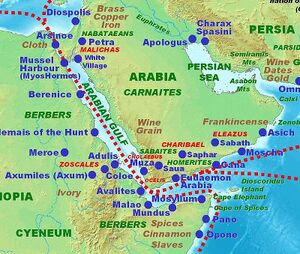Muza
| Author:Laxman Burdak, IFS (R) |


Muza and Musa was an important emporion on the Arabian coast of the Red Sea at the Arabia Felix near the Strait of Bab-el-Mandeb in modern Yemen.[1] Now it is inland from the modern port city of Mokha.
Variants
- Ancient Greek: Μύζα and Μοῦσα and Μοῦζα and Μούζα
- Musa
- Mousa
- Muza Emporion
- Mokha
Jat clans
Present Mokha
Now it is inland from the modern port city of Mokha due to the recession of the coast.[2]
Mokha
Mokha (Arabic: المُخا, romanized: al-Mukhā), also spelled Mocha, or Mukha,[3] is a port city on the Red Sea coast of Yemen. Until Aden and al Hudaydah eclipsed it in the 19th century, Mokha was the principal port for Yemen's capital, Sanaa. Long known for its coffee trade, the city gave its name to Mocha coffee and chocolate.[4] Near the modern Mocha was the important ancient emporion of Muza. Mocha reached its zenith in the 17th century, owing to its trade in coffee.
History
The city was mentioned at the Periplus of the Erythraean Sea,[5] Pliny the Elder's Natural History[6] and the Ptolemy's Geography.[7] [8]
Pliny describe the Musa as the third port of Arabia Felix.[9] The Periplus of the Erythraean Sea has detailed description of its trade.[10]
Mention by Pliny
Pliny[11] mentions....Passengers generally set sail at midsummer, before the rising of the Dog-star, or else immediately after, and in about thirty days arrive at Ocelis28 in Arabia, or else at Cane29, in the region which bears frankincense. There is also a third port of Arabia, Muza30 by name; it is not, however, used by persons on their passage to India, as only those touch at it who deal in incense and the perfumes of Arabia.
More in the interior there is a city; the residence of the king there is called Sapphar31, and there is another city known by the name of Save. To those who are bound for India, Ocelis is the best place for embareation.
28 Now called Gehla, a harbour and emporium at the south-western point of Arabia Felix.
29 An emporium or promontory on the southern coast of Arabia, in the country of the Adramitæ, and, as Arrian says, the chief port of the increase-bearing country. It has been identified by D'Anville with Cava Canim Bay, near a mountain called Hissan Ghorab, at the base of which there are ruins to be seen.
30 Probably the modern Mosch, north of Mokha, near the southern extremity of Arabia Felix.
31 Its ruins are now known as Dhafar. It was one of the chief cities of Arabia, standing near the southern coast of Arabia Felix, opposite the modern Cape Guardafui.
External links
References
- ↑ Dictionary of Greek and Roman Geography (1854), MUZA
- ↑ Dictionary of Greek and Roman Geography (1854), MUZA
- ↑ "Mocha | Yemen". Encyclopædia Britannica.
- ↑ Eschner, Kat. "Your Mocha is Named After the Birthplace of the Coffee Trade". Smithsonian.
- ↑ Periplus of the Erythraean Sea, 7, 16, 17, 21, 24, 28
- ↑ Pliny the Elder, The Natural History, 6.26
- ↑ Dictionary of Greek and Roman Geography (1854), MUZA
- ↑ Periplus of the Erythraean Sea, 7, 16, 17, 21, 24, 28
- ↑ Pliny the Elder, The Natural History, 6.26
- ↑ Dictionary of Greek and Roman Geography (1854), MUZA
- ↑ Natural History by Pliny Book VI/Chapter 26

